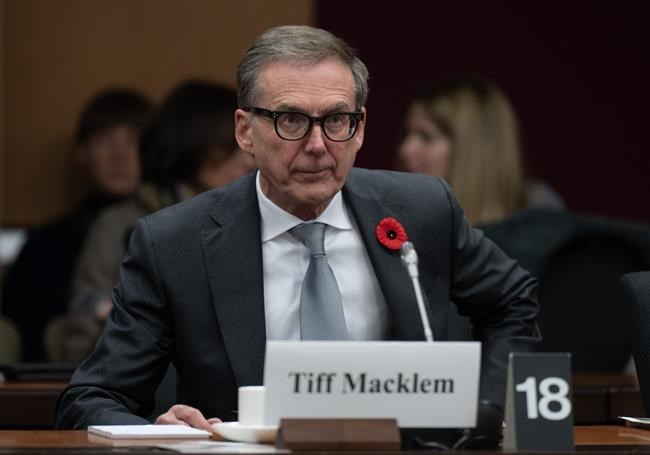OTTAWA — Bank of Canada governor Tiff Macklem says the federal government's new fiscal guardrails unveiled in its fall economic statement are helpful for monetary policy.
During a news conference Wednesday, Macklem weighed in on the federal government's updated fiscal projections as well as new rules that aim to limit deficits.
"From the perspective of monetary policy, the fall economic statement suggests that the government is not adding new or additional inflationary pressures over the next couple of years, which is the critical period over which we will be looking to reduce inflation and get it back to the target," Macklem said.
"The fall economic statement also includes some new fiscal guardrails beyond the near term, and from the perspective of monetary policy, I do think that's helpful."
The fall economic statement made new commitments on how the federal government will approach its finances, including setting a goal to keep deficits below one per cent of GDP beginning in 2026-27.
The Liberals are also aiming to maintain the current fiscal year’s deficit at or below the spring budget projection of $40.1 billion and lower the debt-to-GDP ratio in 2024-25 relative to the projection in the fall economic statement.
The new fiscal objectives come as the federal government faces calls to avoid fuelling inflation with further spending and to be mindful of a slowing economy's impact on government revenues.
Macklem has previously urged for fiscal policy to row in the same direction as monetary policy, noting that on aggregate, spending plans of all levels of government over the next year risk fuelling inflation.
Earlier in the day, the governor delivered a speech to the Saint John Region Chamber of Commerce, where he warned fighting inflation half-heartedly and living with its consequences would be a huge mistake.
He acknowledgedthat interest rates may already be high enough to bring inflation back to target, but doubled down on the central bank's readiness to raise rates further if inflation doesn't come down.
His public appearance came one day after the release of new inflation numbers showing Canada’s inflation rate fell to 3.1 per cent in October, down from a high of 8.1 per cent in the summer of 2022.
Macklem's speechcontrasted the current inflation fight with inflation in the 1970s, highlighting similarities and differences between those two periods of time.
Inflation in the 1970s was also set off by global events, he said,leading to similar consequences to today: people felt ripped off because their wages weren’t keeping up with the cost-of-living and labour strikes were long and frequent.
And while policymakers experimented with price and wage controls as well as slowing the growth of the money supply, the governor said these policies were ineffective.
“And the government and central bank weren’t willing to stay the course — to restrain government spending and tighten monetary policy enough to wring inflationary pressures out of the economy,” Macklem said.
The consequence, he said, was that Canadians lived with high inflation for more than a decade and by the time policymakers realized they needed to do more, inflation was already entrenched in the economy.
“The lesson from the 1970s is that fighting inflation half-heartedly and living with the stress, labour strife and uncertainty inflation can cause would be a huge mistake,” Macklem said.
The Bank of Canada responded to rising inflation starting in March 2022 by rapidly raising interest rates to the highest level in decades. The aggressive rate hikes have slowed spending in the economy as people face higher borrowing costs, particularly many homeowners with mortgages.
The central bank opted to hold its key interest rate steady at five per cent at its last two decision meetings as economic growth halts. It has said it is also taking into consideration that many Canadians will have to renew their mortgages at higher interest rates, meaning more economic pullback is on the way.
"This tightening of monetary policy is working, and interest rates may now be restrictive enough to get us back to price stability. But if high inflation persists, we are prepared to raise our policy rate further," Macklem said Wednesday.
The governor said Canada has two advantages today compared to the 1970s. The first is that people expect inflation to come back down in the long-run and secondly, the Bank of Canada responded forcefully this time with aggressive rate hikes.
“I know that even as our interest rate hikes are bringing inflation down, to many Canadians they feel like another added cost,” he said. “But these rates are relieving price pressures broadly throughout the economy. If we stay the course, the payoff will be worth it.”
This report by The Canadian Press was first published Nov. 22, 2023.
Nojoud Al Mallees, The Canadian Press



